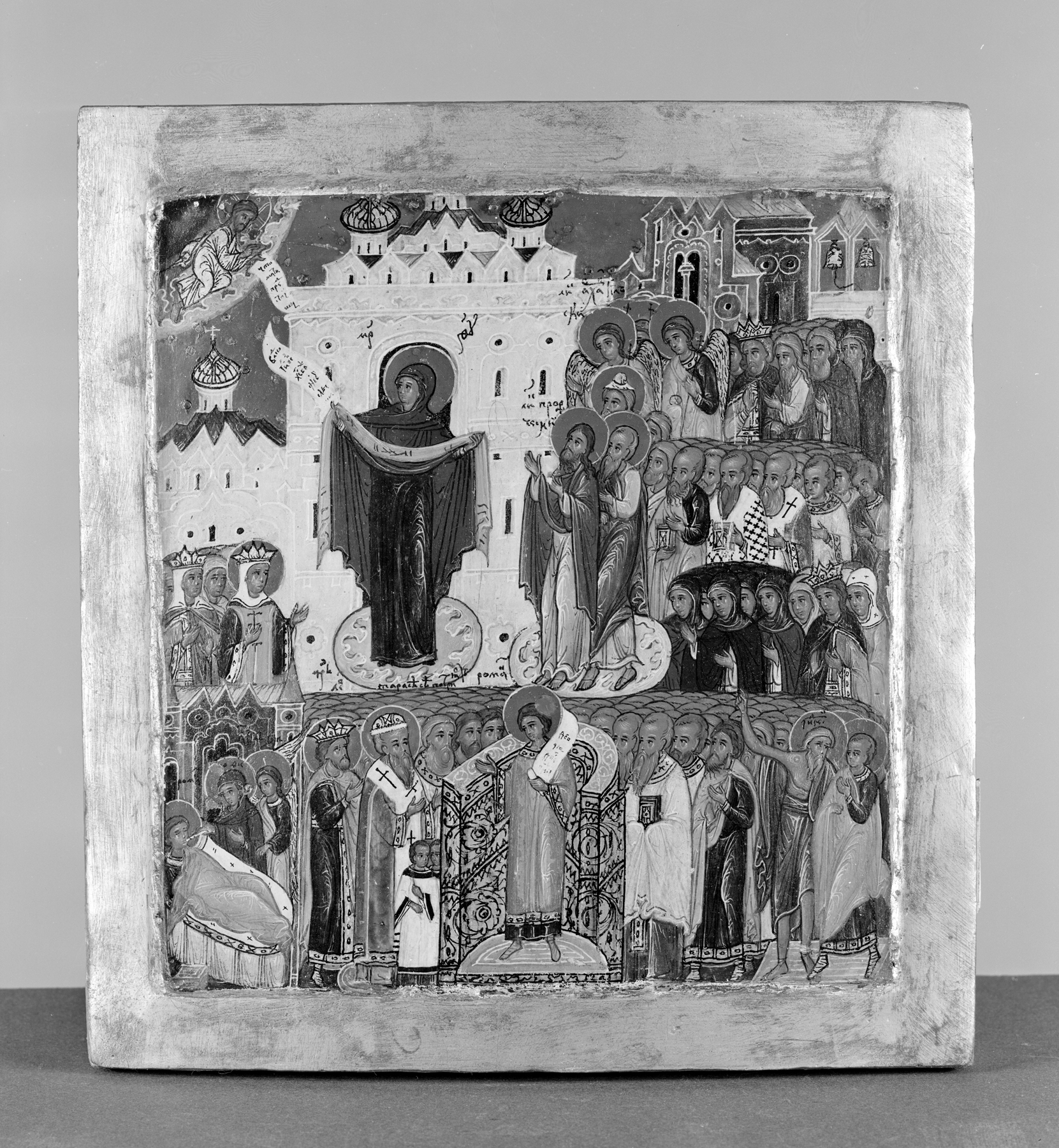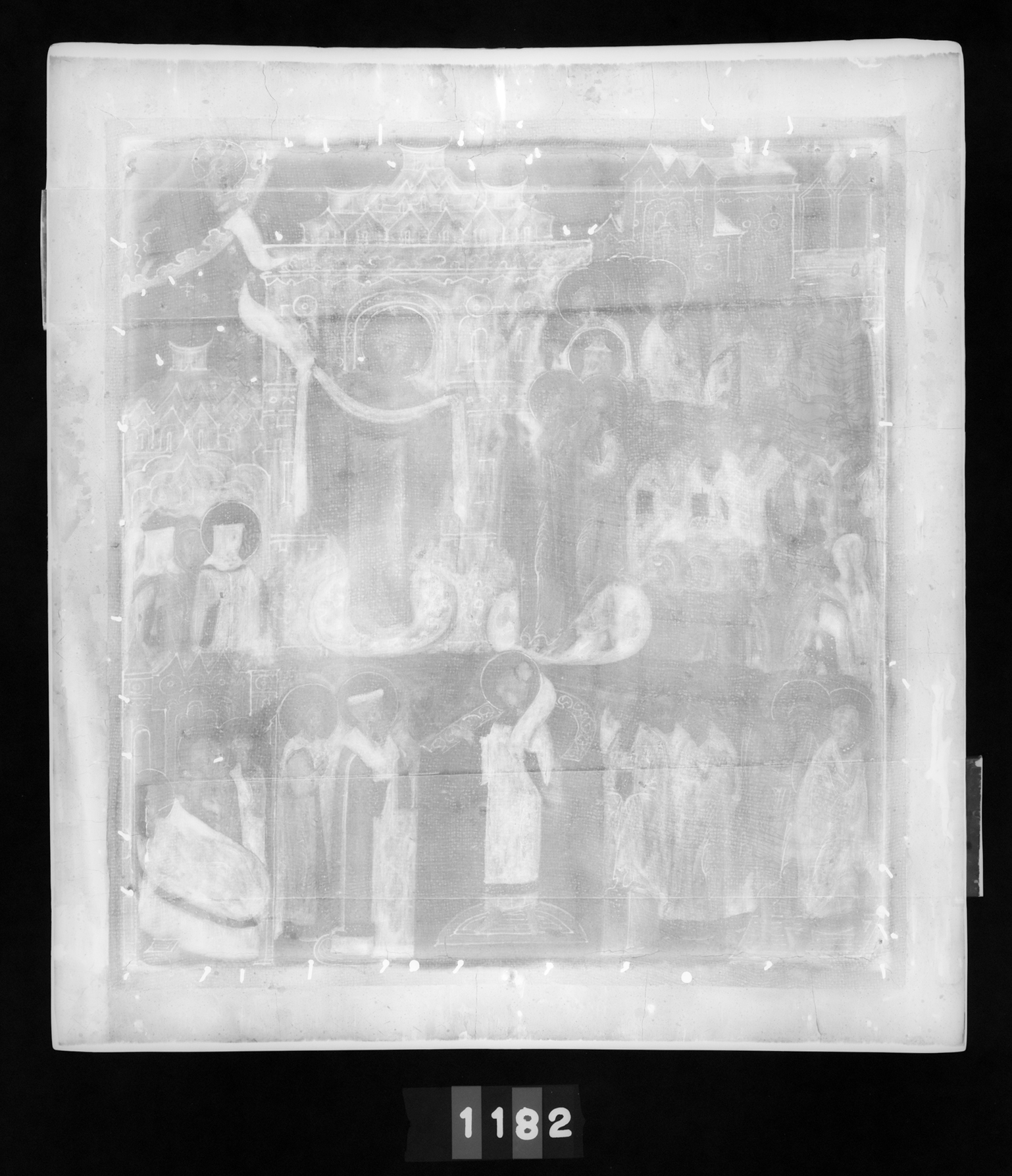The Protecting Veil (Pokrov) of the Mother of God
(Byzantium and Early Russia)
In this traditional composition, celebrating the October 1 church feast of the Protecting Veil (Pokrov) of the Mother of God, the 10th-century Byzantine saint Andrew the Fool for Christ's Sake (at the lower right, arm raised) points out to his disciple Epiphanius a vision that came to him while praying in the Church of the Blachernae in Constantinople. He saw the dome of the church open and the Virgin enter and, after weeping and praying for the world, spread her veil over the congregation. In the upper part of the icon, the Virgin, veil in hand, exchanges letters with Christ, interceding with him on behalf of humanity, while a crowd of saints and angels, led by John the Baptist, joins in her prayer. Behind them are the towers of the Church of the Blachernae. The composition differs slightly from the traditional iconography, in which the Virgin occupies the center (rather than the left side, as she does here), with angels holding her veil above her. Although St. Andrew's vision took place in Byzantium, the feast of Pokrov is celebrated mainly in Russia, where it was introduced in the late 12th century and became the most important event of the liturgical year after the twelve major Christological feasts.
Because his feast day is also October 1, St. Romanus the Melodist frequently appears in Pokrov compositions. Romanus was a deacon in a church dedicated to the Virgin, and although he had many virtues, he was a poor singer. The other deacons often derided Romanus for his voice, and when one year he was assigned to be the lead singer in the Christmas Vigil, responsible not only for singing but for the composition of the music, he was in great despair. The Virgin, however, appeared to him in a dream, instructing him to swallow a scroll that she gave him (in the lower left corner of the icon). The next day, everyone was amazed at Romanus' angelic voice as he sang beautiful, poetic hymns. This was the beginning of a celebrated and prolific career as a hymnographer. In the lower center of the icon, Romanus stands in the pulpit, holding the text of his hymn to the Virgin, surrounded by the emperor Leo the Great, Patriarch Tarasius of Constantinople, and other saints.
The icon's style imitates that of the Stroganov school of icon-painting of the late 16th-early 17th centuries.
Provenance
Provenance (from the French provenir, 'to come from/forth') is the chronology of the ownership, custody, or location of a historical object. Learn more about provenance at the Walters.
Henry Walters, Baltimore, prior to 1909, by purchase; Walters Art Museum, 1931, by bequest.
Exhibitions
| 2014 | Seeing Music in Medieval Manuscripts. The Walters Art Museum, Baltimore. |
| 2002-2005 | Realms of Faith: Medieval and Byzantine Art from the Walters Art Museum. Frist Center for the Visual Arts, Nashville. |
| 2001-2002 | Realms of Faith: Medieval and Byzantine Art from the Walters Art Museum. Frist Center for the Visual Arts, Nashville. |
| 1988-1989 | A Millennium of Christianity: Russian Art from The Walters Art Gallery. The Walters Art Gallery, Baltimore. |
Geographies
Russia (Place of Origin)
Measurements
H: 10 1/4 × W: 9 7/16 × D: 1 9/16 in. (26 × 24 × 4 cm)
Credit Line
Acquired by Henry Walters, before 1909
Location in Museum
Not on view
Accession Number
In libraries, galleries, museums, and archives, an accession number is a unique identifier assigned to each object in the collection.
In libraries, galleries, museums, and archives, an accession number is a unique identifier assigned to each object in the collection.
37.1182




